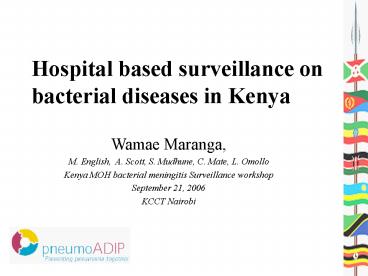Hospital based surveillance on bacterial diseases in Kenya - PowerPoint PPT Presentation
1 / 27
Title:
Hospital based surveillance on bacterial diseases in Kenya
Description:
Deafness. Epilepsy. Severe learning difficulties. Severe behavioural disturbances ... As significant causes of mortality and morbidity bacterial disease surveillance ... – PowerPoint PPT presentation
Number of Views:69
Avg rating:3.0/5.0
Title: Hospital based surveillance on bacterial diseases in Kenya
1
Hospital based surveillance on bacterial diseases
in Kenya
Wamae Maranga, M. English, A. Scott, S. Mudhune,
C. Mate, L. Omollo Kenya MOH bacterial meningitis
Surveillance workshop September 21, 2006 KCCT
Nairobi
2
Presentation overview
- Introduction
- Surveillance of bacterial diseases in Kenya
- WHO/Paediatrics Bacterial meningitis
surveillance - netSPEAR introduction
- Initial and current meningitis surveillance
situation and summary results - Mention of blood cultures
- Challenges and way forward
- Conclusion
3
Meningitis kills or severely disable
- Severe complications affect up to 25-30
- Hemiplegia
- Blindness
- Deafness
- Epilepsy
- Severe learning difficulties
- Severe behavioural disturbances
- Case fatality is high
- Kenya Kilifi - 30 KNH lt1yrs - 15, 1-5yrs -
8 - Burkina Faso 25- 46 (2006)
- Mali - 10 Hib meningitis
- Malawi - 41
4
Changing epidemiology of meningitis
5
Changing epidemiology of meningitis
6
Pneumonia the forgotten killer of children
- Kill over 2 M annually globally
- lt 20 of children with pneumonia get recommended
treatment antibiotics - Significant pneumonia death occur out of
hospital - Affect the most vulnerable
- Malnourished
- Not breastfed exclusively
- Deficiency like Vit. D, Zinc,
- HIV positive
- Poor living conditions e.g. crowded, in-door
pollution, etc
7
(No Transcript)
8
Bacterial meningitis Surveillance in Kenya
- WHO/MOH Paediatrics bacterial meningitis
surveillance since 2001 - KNH was the only site
- To monitor Hib after introduction of the
conjugate Hib Vaccine in Kenya - netSPEAR from Aug. 2003 aim to increase
surveillance activities in line with PBM - Sites increased from 1 to 6
9
Enhanced surveillance in the region (netSPEAR)
10
At the onset of surveillance (Clinical)
- No standard cases definitions
- No case management practices /guidelines
- Incomplete routine documentation
- LP not routine for clinical meningitis
- Missed out a large number of clinical meningitis
11
Clinical laboratories
- Few Laboratories could analyse CSF adequately
- Blood culture capacity limited/non-existent
- No existing SOPs for use for common laboratory
procedures - Lack of standardisation and QA
- Isolation of any organism from CSF was rare
- No SPN isolate in almost all labs for years
12
A surveillance laboratory
13
Support for meningitis surveillance
- SOPs (Clinical and Lab SOPs) following
consultation with clinician and laboratory
representatives - Clinical and lab Supplies as needed
- Sensitisation on case identification /specimen
collection processing based on the SOPs - Data management tool training
- Species re-confirmation and serotyping services
available - Minimum IQA initiative for the labs
14
Support for meningitis surveillance
- EQA with quarterly circulation
- Blood cultures machine and supplies for KNH.
- Some exposure to research laboratory to improves
skills - Sharing/peer review by having whole network
meeting - Feedback from netSPEAR to sites
- Other site specific needs
15
Lumbar puncture Blood cultures posters
16
Flowcharts for use in the laboratory
17
Supporting IQA sites QA assessment
18
Trend on CSF cultures by country
19
All Kenya sites trend for CSF cultures (N6427)
20
Trend for CSF cultures any, SPN Hin isolates
21
Blood cultures results
- Introduced at KNH in May 2005
- Kilifi D. Hospital been carrying blood cultures
from the start of netSPEAR
22
Why blood cultures?
- Will contributes in management of severely sick
children targeted for BC (Pneumonia sepsis). - Well targeted blood cultures in children doubles
the isolation rate of Hib and almost triples that
of Streptococcus pneumoniae - Pneumonia is common and major cause of death
there is inadequate data on what the main causes
are. - As a major cause of pneumonia death pneumococcal
disease sero-type data representing children with
pneumonia is vital
23
Blood cultures trend from Aug-03 to
Jun-06(N17029)
Most BC from Kilifi D. Hospital
24
Kenya Isolate trend for blood cultures
25
Monthly trends on blood cultures
26
Conclusion
- A network for hospital based surveillance of
bacterial diseases in Kenya exist and is being
enhanced in six key public hospitals - To provide vital surveillance data for MOH
- MOH owned surveillance activities can be enhanced
through partnerships with WHO, Kemri, netSPEAR
and others - Main challenge is sustaining and continuous
improvement of performance - As significant causes of mortality and morbidity
bacterial disease surveillance need to be at
similar level with VPD, HIV, Malaria
27
Acknowledgement
- KEMRI/ Wellcome Trust
- Pneumo-ADIP
- WHO AFRO, WHO ICP, WHO country offices
- MOH (KEPI, NPHL all Participating hospitals)
- GSK Biologicals for supporting network
conference since 2005































